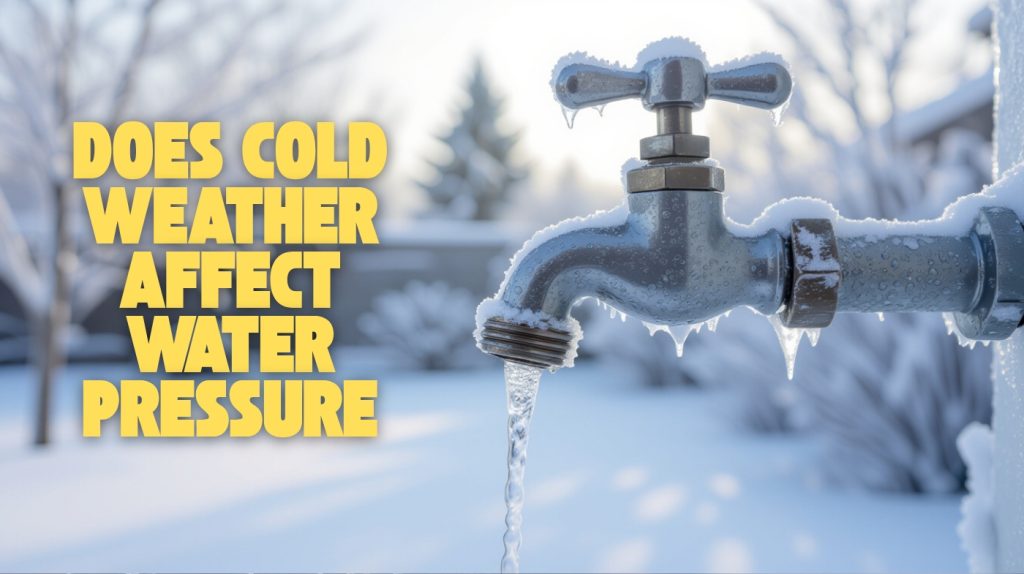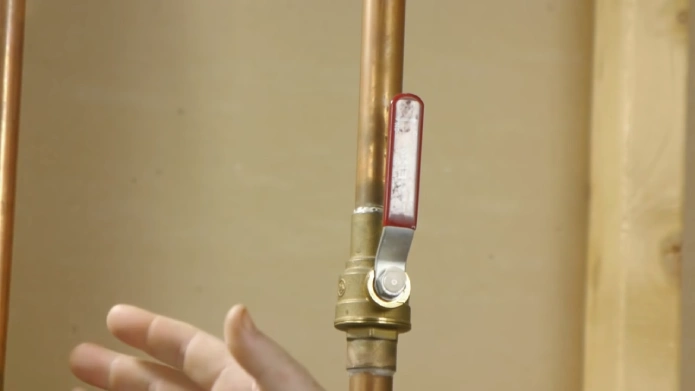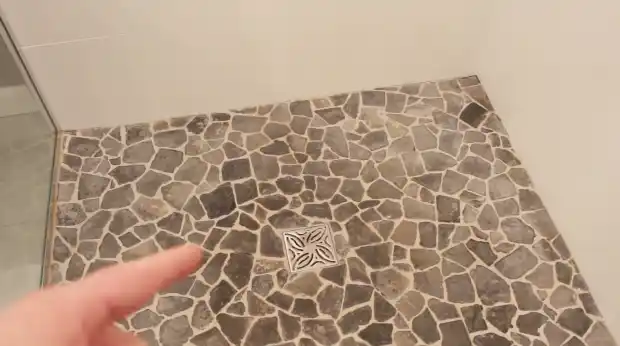Last Updated on August 11, 2025
Yes, cold weather can directly affect your water pressure by freezing pipes inside walls or underground, creating ice blockages that restrict flow and lower pressure.
Your municipal system may also experience pressure fluctuations due to increased indoor water use and sediment buildup during winter.
Aging or poorly insulated pipes are especially vulnerable to cracking or bursting from ice expansion, causing sudden drops or loss of pressure.
Understanding these factors can help you better manage and protect your water supply in freezing conditions.
Key Takeaways
- Cold weather causes water inside pipes to freeze, creating blockages that reduce or stop water pressure downstream.
- Expansion of freezing water increases pressure inside pipes, risking cracks or bursts that disrupt pressure stability.
- Winter increases indoor water demand, causing urban systems to experience fluctuating water pressure between 62 and 72 psi.
- Aging and sediment-clogged pipes exacerbate winter pressure drops due to narrowed flow paths and freeze-thaw damage.
- Regional climate, infrastructure age, and insulation levels influence how significantly cold weather impacts water pressure.
Common Causes of Water Pressure Drops During Winter
When winter arrives, you might notice your water pressure drops due to several common factors. Increased municipal water demand strains supply systems as heating, showers, and hot drinks peak simultaneously, causing measurable pressure dips, especially if the infrastructure is older.
Cold temperatures also promote sediment buildup in pipes, narrowing flow paths as minerals like calcium precipitate more readily. Additionally, pipe materials contract in the cold, slightly reducing internal diameters and flow rates, particularly in unheated areas.
Cold weather causes pipes to shrink and sediment to build up, restricting water flow significantly.
Partially closed or stiff valves from cold-induced freezing can restrict flow further, mimicking other pressure issues. Finally, winter moisture accelerates pipe corrosion, roughening interiors and creating blockages that impede water movement.
Regular maintenance, including pipe flushing and valve inspection, helps you mitigate these common winter pressure problems effectively. Another possible cause is mineral scale buildup inside pumps and pipes, which reduces water flow and pressure over time.
How Frozen Pipes Impact Water Flow?
When water inside your pipes freezes, the expanding ice creates blockages that considerably restrict flow. These blockages may require careful draining procedures to alleviate pressure and prevent damage.
This expansion builds pressure within the pipe, which can lead to cracks or bursts if not addressed promptly. Frozen pipes block water flow, disrupting daily activities such as hygiene, cooking, and heating, making immediate action crucial to prevent damage. blocked water flow
Understanding how these ice blockages and pressure changes affect your water system is essential to maintaining consistent water flow during cold weather.
Ice Blockages Restrict Flow
Although ice blockages form inside pipes due to freezing water, they immediately restrict or completely stop water flow, creating a physical barrier that prevents liquid from moving beyond the frozen section.
When pipes freeze, you’ll notice reduced or no water pressure downstream, as the ice acts like a solid dam. This blockage can cause major inconvenience and safety issues, including loss of running water for daily needs.
Prolonged blockage can also place excessive pressure on the plumbing system, increasing the risk of pipe bursts. Here’s what happens with ice blockages:
- Water flow is partially or fully restricted, cutting off access to faucets.
- Pressure drops markedly downstream, limiting water availability.
- Blocked flow risks pipe damage if pressure builds behind the ice.
- If not addressed promptly, frozen pipes can lead to costly repairs and water damage.
Pipe Expansion Causes Pressure
Because water expands as it freezes, the pressure inside your pipes can skyrocket, potentially causing serious damage. Ice forms plugs inside pipes, trapping liquid water that continues to expand. Since water is incompressible, pressure builds up, often exceeding the pipe’s burst strength.
This pressure can rupture pipes downstream from the frozen section, not necessarily at the ice blockage itself. The crystalline structure formed during freezing is the reason for this unusual expansion and pressure increase, which can generate forces up to 40,000 psi within the pipes.
Managing operating conditions such as flow rate and pressure can help mitigate damage risks.
| Pipe Material | Burst Pressure (psi) | Freeze Resistance |
|---|---|---|
| Copper | 3000–4000 | High |
| CPVC | ~1250 | Moderate |
| PEX | ~475 | Low (despite flexibility) |
Role of Municipal Water Demand in Cold Weather Pressure Changes
You’ll notice that municipal water demand spikes in cold weather as households increase indoor usage and heating systems consume more water. This surge places additional pressure on urban distribution networks, often leading to reduced flow and fluctuating system pressures.
In many older cities, aging pipes with insufficient insulation are particularly vulnerable to freezing, which can exacerbate pressure problems during these demand peaks freezing pipes.
Managing these demand-driven variations is critical to maintaining consistent water delivery throughout winter months. Additionally, continuous operation of pumps in municipal systems can increase wear and risk of failure if not properly managed.
Winter Water Demand Impact
When temperatures drop, municipal water demand shifts markedly as indoor usage increases to support heating, sanitation, and daily activities. This rise in demand stresses the distribution system, affecting water pressure dynamics.
Solar-powered well pumps can help mitigate pressure variability by providing reliable water supply in off-grid or stressed systems through solar energy efficiency.
You’ll notice that colder weather causes water to flow more frequently indoors, elevating consumption patterns and pressure variability.
Additionally, cold weather can intensify the impact of increased water use on system reliability, requiring careful planning and maintenance. Key factors influencing winter water demand impact include:
- Increased indoor water use for heating systems and sanitation, raising overall municipal demand.
- Reduced outdoor water use, changing the balance of pressure fluctuations in the distribution network.
- Slower turnover rates overnight, increasing risks of localized freezing and pressure drops if flow isn’t maintained.
Urban Usage Pressure Effects
Although cold weather increases indoor water demand, it also places significant stress on municipal water systems, directly affecting urban water pressure.
When many residents increase usage simultaneously to prevent pipe freezing, utilities often reduce system-wide pressure from typical 68-72 psi down to about 62 psi to manage supply and avoid failures.
This seasonal increased demand combined with municipal water supply issues can cause noticeable pressure fluctuations. In some cases, automatic bilge pumps are used in urban plumbing to help prevent flooding from burst or frozen pipes.
Freezing pipes and aging infrastructure compound pressure loss by restricting flow or causing leaks. Main line breaks, more frequent in cold snaps, cause abrupt local pressure drops and network instability, forcing further pressure adjustments or shutdowns.
To maintain safe operations, utilities monitor demand in real time, adjusting pressure dynamically and communicating with emergency services to preserve firefighting capabilities despite lower pressures.
Effects of Sediment Buildup on Winter Water Pressure
Since sediment buildup narrows the internal diameter of pipes, it directly causes a measurable drop in water pressure during winter months. Cold weather increases suspended particles like iron, carbon, and mineral deposits in your water supply, which settle and form scale inside pipes.
This restricts flow, especially under higher winter demand, causing uneven pressure drops at fixtures. Monitoring the automatic shut-off valve can help detect unusual flow changes caused by sediment accumulation.
You can observe this impact through:
- Slower water flow or irregular spray from faucets and showerheads.
- Discolored water and foul odors indicating blockages.
- Frequent localized pressure drops, often in bathrooms or basements.
These sediment deposits worsen with hard water, accelerating scale formation and impairing plumbing appliance performance.
Additionally, sediment buildup can cause blockages that decrease water pressure and contribute to plumbing issues during cold weather. Regular flushing and water treatment help maintain proper pressure by reducing sediment accumulation during cold seasons.
Vulnerability of Aging Plumbing Systems to Cold Weather
As temperatures fall, aging plumbing systems face heightened risks due to material degradation and inadequate insulation. Pipes made from galvanized steel or old copper contract and expand with cold, increasing fracture risks during freeze-thaw cycles.
Corroded walls and weak joints often fail under ice expansion, as water freezing inside pipes increases pressure by about 9%, frequently exceeding pipe tensile strength. Insufficient insulation in unheated areas like basements exposes pipes to freezing, causing blockages and pressure imbalances.
Additionally, aging water heaters struggle to heat colder water, causing uneven thermal expansion that accelerates pipe wear.
Without modern protective measures, these vulnerabilities lead to frequent leaks, bursts, and water damage, making older plumbing systems particularly susceptible to cold-weather-induced pressure problems and failures.
Submersible pumps, with their sealed construction, offer enhanced reliability in challenging conditions compared to older pump systems.
Geographic Differences in Winter Water Pressure Issues
You’ll notice winter water pressure issues vary widely between urban and rural areas, largely due to differences in infrastructure and water source vulnerabilities. Using an extension cord that meets power requirements can ensure reliable operation of water pumps in cold weather conditions.
Colder regions with older pipe systems face higher risks of freezing and pressure drops, while newer, better-insulated networks manage these challenges more effectively.
Understanding these geographic and temperature-related factors helps you anticipate and address winter water pressure problems precisely.
Proper insulation and heating of well components are essential to prevent frozen pipes which directly cause pressure loss during cold weather prevention strategies.
Urban vs Rural Pressure
Although both urban and rural water systems face pressure challenges during winter, their underlying causes and impacts differ markedly due to geographic and infrastructural factors. You’ll notice urban systems often have older, dense piping prone to leaks but benefit from insulation and quicker repairs.
Rural systems, with simpler, linear networks, face deeper frost penetration and limited emergency response, increasing freeze risks. Studies show that regional climate plays a significant role in how infrastructure responds to prolonged cold episodes, influencing pressure stability.
Consider these key differences:
- Urban systems manage peak demand spikes and reroute pressure losses through complex networks, while rural ones rely on fewer supply lines, making failures more disruptive.
- The urban heat island effect buffers frost impact, reducing underground pipe freezing compared to rural zones.
- Rural areas struggle with power outages affecting pumps, compounding pressure drops, whereas urban utilities often possess robust monitoring and rapid remediation capabilities.
Regional Temperature Effects
When temperatures plunge and stay below freezing for extended periods, you’ll encounter more frequent water pressure issues caused by frozen pipes and heightened demand.
Regions like northern and mountainous areas face persistent pressure drops due to sustained pipe freezing and increased residential hot water use. Freezing pipes restrict water flow and can lower pressure, which further exacerbates these regional challenges.
In contrast, milder climates see fewer problems, though sudden cold snaps can trigger temporary dips. Rapid temperature swings cause partial freezing and thawing cycles, leading to intermittent pressure inconsistencies.
Urban and rural microclimates within the same region also influence freezing risk and pressure stability. Additionally, areas with high seasonal population surges or winter irrigation face compounded demand strains.
Soil composition and frost depth vary regionally, affecting pipe integrity and pressure. Knowing your local temperature patterns helps anticipate and mitigate winter water pressure challenges effectively.
Infrastructure Age Impact
Because aging infrastructure directly affects winter water pressure reliability, understanding its geographic variations is crucial for effective management.
You’ll find older pipes, especially those over 75 years old, more vulnerable to brittleness and cracking in cold weather, with cast iron and ductile iron materials failing more often during freeze-thaw cycles.
The analysis of failure rates across pipe age groups shows that older pipes have higher failure frequencies, underscoring the importance of age in assessing winter pressure issues.
Geographic differences arise due to pipe age, material, and local winterization practices. Consider these key points for managing winter water pressure issues by region:
- Urban areas with dense, historic infrastructure face compounded failures causing pressure drops.
- Rural regions experience fewer fluctuations but longer repair times due to sparse aging networks.
- Areas lacking adequate pipe insulation report higher freeze-related pressure problems.
Preventative Measures to Protect Pipes From Freezing
To effectively prevent your pipes from freezing during cold weather, you need to combine insulation, controlled water flow, and physical barriers tailored to your home’s specific vulnerabilities.
Start by insulating pipes in unheated areas with foam or fiberglass tubes sized precisely for a snug fit. Supplement insulation with self-regulating heat tracing cables on critical or previously frozen pipes for consistent warmth.
Maintain minimal water flow by dripping faucets farthest from the main valve during extreme cold to reduce ice formation. This is important because moving water does not prevent freezing. Open cabinet doors beneath sinks on exterior walls to allow warm air circulation.
Seal cracks and gaps in exterior walls and crawl spaces using foam or caulk to block cold drafts. Close and drain outside valves but leave them open after draining to prevent pressure buildup.
Maintenance Tips to Maintain Water Pressure in Cold Months
After taking steps to safeguard your pipes from freezing, maintaining steady water pressure becomes the next priority to guarantee reliable plumbing performance throughout cold months.
Focus on these key maintenance tips:
- Monitor and adjust main water valves: Ensure valves near your water meter are fully open and functioning properly. Turn valves counterclockwise if you notice pressure drops to maximize flow. Regular inspections are important since valves can become sticky or brittle in cold weather, affecting operation.
- Manage household water demand: Stagger the use of appliances like washers and dishwashers to avoid overloading the system simultaneously, reducing sharp pressure fluctuations.
- Flush your system regularly: Clear sediment buildup by shutting off water, opening all faucets, then restoring flow. This prevents partial clogs that restrict pressure and damage pipes.
Practical Advice for Managing Water Pressure in Winter
Although cold weather poses significant risks to your plumbing, you can effectively manage water pressure by maintaining controlled water flow and protecting infrastructure from freezing temperatures.
To prevent pipe freezing and pressure fluctuations, start by allowing faucets to drip slowly during cold spells, ensuring constant water movement. Next, insulate exposed pipes and pump enclosures with foam sleeves or heating cables to maintain temperature and prevent ice buildup.
Proper insulation helps avoid ice formation that can cause system malfunction. Finally, stagger the use of multiple water appliances to avoid sudden pressure drops that strain your system.
- Keep water flowing steadily—use faucet drips or recirculation systems controlled by timers or sensors.
- Insulate pipes and pump houses thoroughly to block cold air infiltration.
- Manage appliance usage timing to maintain consistent pressure and reduce system stress.
Frequently Asked Questions
Can Water Pressure Drops in Winter Affect Fire Sprinkler Systems?
Sure, your fire sprinklers love playing freeze tag in winter, but when water pressure drops, they lose the game badly. You need consistent pressure to guarantee pipes don’t freeze or burst, keeping sprinklers ready to fight fires.
Dropping pressure risks delayed activation or system failure. So, monitor pressure daily, maintain heat, and use antifreeze where needed. Don’t let cold weather turn your safety system into a decorative ice sculpture.
Do Water Softeners Help Reduce Winter Water Pressure Issues?
You’ll find that properly maintained water softeners help reduce winter water pressure issues by preventing mineral buildup in pipes, which can restrict flow. However, if your softener isn’t winterized or sized correctly, salt bridges and freezing can cause blockages, lowering pressure.
To guarantee ideal flow during cold months, you should regularly clean resin beds, prevent freezing, and clear salt bridges. This proactive maintenance keeps your system running efficiently and maintains steady water pressure.
How Do Cold Weather Water Pressure Changes Impact Irrigation Systems?
Oh, sure, you love waking up to burst pipes when temperatures drop, right? Cold weather freezes water inside your irrigation pipes, causing pressure to spike and often crack or burst them.
You’ll want to expel all residual water using air blowouts before the freeze hits, or risk costly repairs. Keep valves slow to avoid pressure surges.
Are There Specific Pipe Materials Better for Cold Climates?
You’ll want to choose pipe materials with high freeze resistance and flexibility for cold climates. PPR pipes handle temperature shifts well without brittleness, reducing leaks. PEX, especially PEX-A, offers superior expansion and freeze protection.
PVC’s tensile strength improves in cold, but proper installation is key to avoid stress. CPVC needs careful solvent cementing and expansion considerations. Selecting these materials helps maintain water system reliability despite freezing conditions.
Can Smart Home Devices Alert to Low Water Pressure in Winter?
Yes, smart home devices can alert you to low water pressure in winter. They use pressure sensors and smart relays to monitor your system continuously, notifying you via app or in-home alarms if pressure drops below set thresholds.
Many models integrate freeze detection, so you get early warnings about potential pipe issues caused by cold. You can customize alerts to track both pressure loss and restoration, helping you act quickly to prevent damage.
Don’t Let Winter Win: Fight Back with Smart Plumbing Prep
As winter’s icy grip tightens, your water pressure can dwindle like a fading river, squeezed by frozen pipes and sediment buildup. By understanding these cold-weather culprits and taking proactive steps—like insulating pipes and monitoring municipal demand—you’ll keep your flow steady and strong.
Think of your plumbing as a essential artery; with proper care, you’ll prevent costly bursts and maintain reliable water pressure, even when frost tries to clamp down hard.



